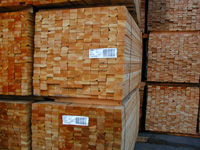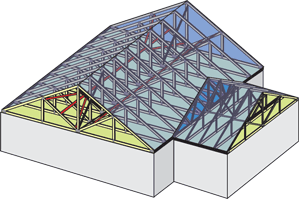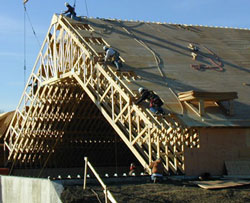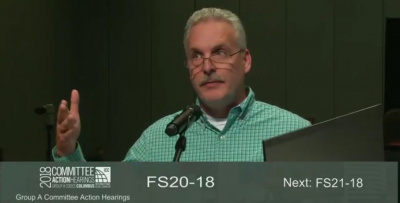Each of the templates in this library are available for you to copy for use in a social media campaign on Facebook, Twitter or LinkedIn. Thesy pair graphics or photos available through the CM Toolbox with sample text you can customize to promote specific products or raise awareness of CM Toolbox materials you have posted on your website. Review the Toolbox Guidance Documents to explore how these resources can be used to promote specific products or your overall marketing campaign in conjunction with other CM Toolbox materials. Need more ideas for quick posts? Visit SBCA’s Facebook page or LinkedIn profile and share our posts.
Learn more about SBCA's educational resources including Business Solutions Groups, Podcasts, Technical FAQs and Webinars and more.
BCSI is the truss industry's guide for jobsite safety and truss performance that includes the most current information regarding the handling, installation, restraining and bracing of metal plate connected wood trusses.
 The BCSI B-Series Summary Sheets summarize each of the chapters of the BCSI book. Focusing on key issues related to handling, installing and bracing components, Summary Sheets are ideal for:
The BCSI B-Series Summary Sheets summarize each of the chapters of the BCSI book. Focusing on key issues related to handling, installing and bracing components, Summary Sheets are ideal for:
- Jobsite Packages
- Handouts for educational presentations
- Project meetings
SBCA desires to promote the safe, economic, and structurally sound use of structural building components. Through this, SBCA is committed to providing the construction industry and fire service with accurate information regarding the use of metal plate connected wood trusses.
SBCA’s QC Committee and Board have undertaken a critical industry project entitled Digital QC and SBCRI’s 3rd Party Digital QA, which defines a quick and accurate method for component manufacturers to evaluate the quality of a truss anywhere and at any time.
A list of common terminology used in the industry.
Educate your customers and protect your business with best practice information regarding handling and installing components.
The following resources are for specifying metal plate connected wood trusses:
 Truss manufacturing uses structural grades of 2x_ dimension lumber that is either visually graded or machine graded. The species of lumber used by a truss manufacturing operation is based on what is readily available in the regional market. In general, southeastern U.S. truss manufacturers often use Southern Pine; western manufacturers use Douglas Fir, Larch and Hemlock Fir; and northern manufacturers use Spruce-Pine-Fir.
Truss manufacturing uses structural grades of 2x_ dimension lumber that is either visually graded or machine graded. The species of lumber used by a truss manufacturing operation is based on what is readily available in the regional market. In general, southeastern U.S. truss manufacturers often use Southern Pine; western manufacturers use Douglas Fir, Larch and Hemlock Fir; and northern manufacturers use Spruce-Pine-Fir.
 There are different types of loads that act on structures:
There are different types of loads that act on structures:
 Bracing provides stability against unintended movement or motion.
Bracing provides stability against unintended movement or motion.
Temporary installation restraint/bracing consists of lateral restraint and diagonal bracing installed during construction for the purpose of holding trusses in their proper location.
Permanent bracing is intended to resist forces from gravity, wind seismic and other loads.
 Long span trusses are 60' or greater in length. A long span truss can pose a greater risk to installers because the dimensions and weight of the truss itself can create instability, buckling and collapse of the truss if it is not handled, installed and braced properly. Long span trusses can be installed safely and efficiently but they require more detailed safety and handling measures than short span trusses.
Long span trusses are 60' or greater in length. A long span truss can pose a greater risk to installers because the dimensions and weight of the truss itself can create instability, buckling and collapse of the truss if it is not handled, installed and braced properly. Long span trusses can be installed safely and efficiently but they require more detailed safety and handling measures than short span trusses.
As a national member-driven association, SBCA is intimately involved with local, state, and national building codes to ensure they are written, and implemented favorably, so not to negatively impact SBCA members. SBCA has successfully developed and argued for the adoption of several changes and new codes in the International Building Code.
On every project, it's important to clarify the design responsibilities when metal plate connected wood trusses are incorporated into a building or structure.





 The BCSI B-Series Summary Sheets summarize each of the chapters of the
The BCSI B-Series Summary Sheets summarize each of the chapters of the 
 Truss manufacturing uses structural grades of 2x_ dimension lumber that is either visually graded or machine graded. The species of lumber used by a truss manufacturing operation is based on what is readily available in the regional market. In general, southeastern U.S. truss manufacturers often use Southern Pine; western manufacturers use Douglas Fir, Larch and Hemlock Fir; and northern manufacturers use Spruce-Pine-Fir.
Truss manufacturing uses structural grades of 2x_ dimension lumber that is either visually graded or machine graded. The species of lumber used by a truss manufacturing operation is based on what is readily available in the regional market. In general, southeastern U.S. truss manufacturers often use Southern Pine; western manufacturers use Douglas Fir, Larch and Hemlock Fir; and northern manufacturers use Spruce-Pine-Fir. There are different types of loads that act on structures:
There are different types of loads that act on structures: Bracing provides stability against unintended movement or motion.
Bracing provides stability against unintended movement or motion. Long span trusses are 60' or greater in length. A long span truss can pose a greater risk to installers because the dimensions and weight of the truss itself can create instability, buckling and collapse of the truss if it is not handled, installed and braced properly. Long span trusses can be installed safely and efficiently but they require more detailed safety and handling measures than short span trusses.
Long span trusses are 60' or greater in length. A long span truss can pose a greater risk to installers because the dimensions and weight of the truss itself can create instability, buckling and collapse of the truss if it is not handled, installed and braced properly. Long span trusses can be installed safely and efficiently but they require more detailed safety and handling measures than short span trusses. 